Hello, KAN!
Kolmogorov-Arnold representation theorem
Kolmogorov-Arnold representation theorem states that if \(f\) is a multivariate continuous function on a bounded domain, then it can be written as a finite composition of continuous functions of a single variable and the binary operation of addition. More specifically, for a smooth \(f : [0,1]^n \to \mathbb{R}\),
where \(\phi_{q,p}:[0,1]\to\mathbb{R}\) and \(\Phi_q:\mathbb{R}\to\mathbb{R}\). In a sense, they showed that the only true multivariate function is addition, since every other function can be written using univariate functions and sum. However, this 2-Layer width-\((2n+1)\) Kolmogorov-Arnold representation may not be smooth due to its limited expressive power. We augment its expressive power by generalizing it to arbitrary depths and widths.
Kolmogorov-Arnold Network (KAN)
The Kolmogorov-Arnold representation can be written in matrix form
where
We notice that both \({\bf \Phi}_{\rm in}\) and \({\bf \Phi}_{\rm out}\) are special cases of the following function matrix \({\bf \Phi}\) (with \(n_{\rm in}\) inputs, and \(n_{\rm out}\) outputs), we call a Kolmogorov-Arnold layer:
\({\bf \Phi}_{\rm in}\) corresponds to \(n_{\rm in}=n, n_{\rm out}=2n+1\), and \({\bf \Phi}_{\rm out}\) corresponds to \(n_{\rm in}=2n+1, n_{\rm out}=1\).
After defining the layer, we can construct a Kolmogorov-Arnold network simply by stacking layers! Let’s say we have \(L\) layers, with the \(l^{\rm th}\) layer \({\bf \Phi}_l\) have shape \((n_{l+1}, n_{l})\). Then the whole network is
In constrast, a Multi-Layer Perceptron is interleaved by linear layers \({\bf W}_l\) and nonlinearities \(\sigma\):
A KAN can be easily visualized. (1) A KAN is simply stack of KAN layers. (2) Each KAN layer can be visualized as a fully-connected layer, with a 1D function placed on each edge. Let’s see an example below.
Get started with KANs
Initialize KAN
from kan import *
# create a KAN: 2D inputs, 1D output, and 5 hidden neurons. cubic spline (k=3), 5 grid intervals (grid=5).
model = KAN(width=[2,5,1], grid=5, k=3, seed=0)
Create dataset
# create dataset f(x,y) = exp(sin(pi*x)+y^2)
f = lambda x: torch.exp(torch.sin(torch.pi*x[:,[0]]) + x[:,[1]]**2)
dataset = create_dataset(f, n_var=2)
dataset['train_input'].shape, dataset['train_label'].shape
(torch.Size([1000, 2]), torch.Size([1000, 1]))
Plot KAN at initialization
# plot KAN at initialization
model(dataset['train_input']);
model.plot(beta=100)
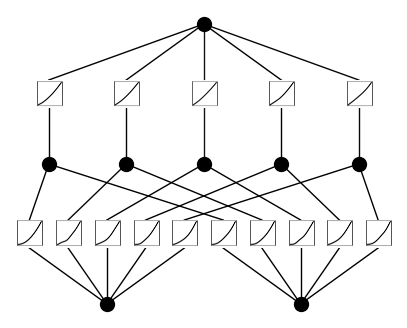
Train KAN with sparsity regularization
# train the model
model.train(dataset, opt="LBFGS", steps=20, lamb=0.01, lamb_entropy=10.);
train loss: 1.57e-01 | test loss: 1.31e-01 | reg: 2.05e+01 : 100%|██| 20/20 [00:18<00:00, 1.06it/s]
Plot trained KAN
model.plot()
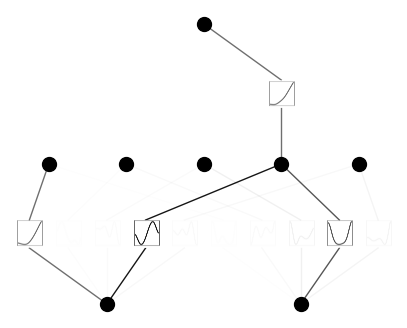
Prune KAN and replot (keep the original shape)
model.prune()
model.plot(mask=True)
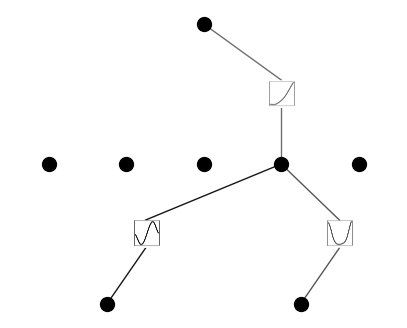
Prune KAN and replot (get a smaller shape)
model = model.prune()
model(dataset['train_input'])
model.plot()
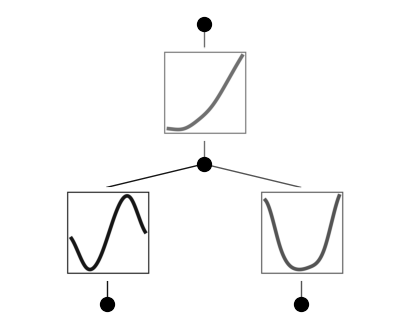
Continue training and replot
model.train(dataset, opt="LBFGS", steps=50);
train loss: 4.74e-03 | test loss: 4.80e-03 | reg: 2.98e+00 : 100%|██| 50/50 [00:07<00:00, 7.03it/s]
model.plot()
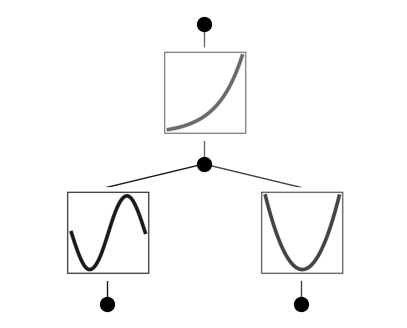
Automatically or manually set activation functions to be symbolic
mode = "auto" # "manual"
if mode == "manual":
# manual mode
model.fix_symbolic(0,0,0,'sin');
model.fix_symbolic(0,1,0,'x^2');
model.fix_symbolic(1,0,0,'exp');
elif mode == "auto":
# automatic mode
lib = ['x','x^2','x^3','x^4','exp','log','sqrt','tanh','sin','abs']
model.auto_symbolic(lib=lib)
fixing (0,0,0) with sin, r2=0.999987252534279
fixing (0,1,0) with x^2, r2=0.9999996536741071
fixing (1,0,0) with exp, r2=0.9999988529417926
Continue training to almost machine precision
model.train(dataset, opt="LBFGS", steps=50);
train loss: 2.02e-10 | test loss: 1.13e-10 | reg: 2.98e+00 : 100%|██| 50/50 [00:02<00:00, 22.59it/s]
Obtain the symbolic formula
model.symbolic_formula()[0][0]